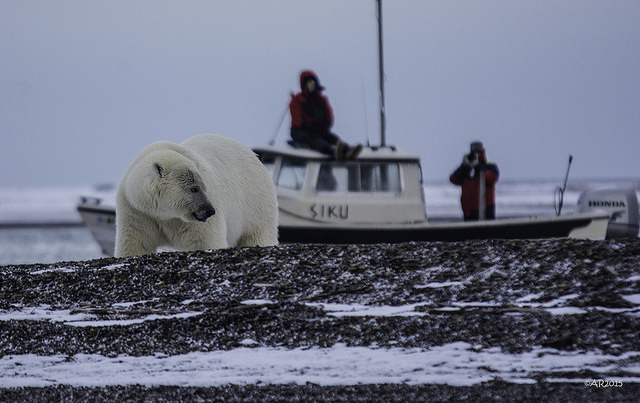Does human recreation in the Arctic put polar bears at risk?
Arctic activities could hurt polar bears, but it won’t matter if sea ice keeps melting
Tara Santora • November 9, 2018

“Polar bear conservation depends on you and I and our societies changing the way we live,” says polar bear researcher Steven Amstrup. [Image courtesy of Flickr user Anita Ritenour | CC BY 2.0]
Snowmobiling in the Arctic sounds like a thrill-seeker’s dream, but could it be a polar bear’s nightmare? Arctic activities aren’t hurting most polar bears, at least for the moment, new research shows. But experts say the negative impacts of recreation in the Arctic — such as snowmobiling, camping, and boating — could increase as the Earth continues to warm.
Sea ice melt, caused by global warming, is currently the biggest threat to polar bears. These furry creatures spend most of their lives on sea ice, where they prey on seals. “If the sea ice goes away, the polar bears will too,” says Steven Amstrup, Chief Scientist at Polar Bears International.
Polar bear conservationists can’t do much to curb carbon emissions or stop sea ice from melting, so many are focusing on ground-level threats and ways to mitigate them, Amstrup says.
That’s what led to a recent study in Biological Conservation that investigated whether ventures like dogsledding, skiing, and hunting could be one such threat. Researchers surveyed dozens of experts and local leaders about the prevalence and impacts of these regional hobbies and tourist exploits on polar bears.
Respondents estimated that less than 10 percent of polar bears interact with human recreation, and nearly half of people surveyed thought most of these Arctic activities hurt polar bears. But the fun and games are due to grow—and as sea ice melts, more polar bears spend the summer months onshore, where they are more likely to interact with humans.
As bears come into contact with adventure-goers, the animals become more comfortable around humans and approach them more often. A lumbering bear could provoke someone into shooting the predator in defense. What’s more, encountering humans in their habitats could also make polar bears leave their icy homes, causing them to burn precious energy, says Karyn Rode, co-author of the study and a wildlife biologist for the U.S. Geological Survey.
Still, these threats pale in comparison to the bears’ shrinking habitat, says Amstrup, who was not involved in the new research. In the hopeful (and increasingly unlikely) case that we stabilize the amount of carbon in the atmosphere, halting sea ice melt, many more bears would be left alive and healthy. So by limiting our recreational activities in polar bear habitats now, leaving them with better survival rates and better numbers, we set them up with a better chance for survival with shrinking sea ice.
To address the bears’ most pressing problem and stop sea ice melt, serious change is needed. Governments must curb carbon emissions and stabilize the amount of carbon in the atmosphere, according to Amstrup. He says following the guidelines of the 2015 Paris Agreement, which the United States withdrew from in 2017, would put us on the right track.
“Worrying about tourism, worrying about other human intrusions into the Arctic — none of that really matters in the long run if we don’t halt sea ice loss,” Amstrup says.